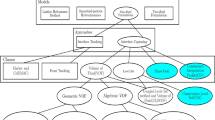Abstract
Integrated radial basis function based on finite difference (IRBF–FD) method is presented in this paper for the solution of incompressible Navier–Stokes equations. A semi-implicit temporal scheme is first used to discretize the time variable of the incompressible Navier–Stokes (NS) equations. We consider the same discrete scheme for the time variable for both pressure–Poisson equation and vorticity stream function formulation. For solving lid-driven cavity flow and backward-facing step flow, we used the vorticity-stream formulation. The proposed method approximates the function derivatives at a knot in terms of the function values on a collection of nodes existing in the support domain of the node. We also utilize an algorithm for finding the optimal shape parameter for each stencil based on the range of condition numbers. It can be seen that no special treatment is needed to impose the essential boundary conditions. The efficiency, accuracy and robustness of the presented method are demonstrated by comparing the current method with existing methods.


















Similar content being viewed by others
References
Abbaszadeh M, Dehghan M (2020) Reduced order modeling of time-dependent incompressible Navier–Stokes equation with variable density based on a local radial basis functions-finite difference (LRBF-FD) technique and the POD/DEIM method. Comput Meth Appl Mech Engin 364:112914
Abide S, Viazzo S (2005) A 2D compact fourth-order projection decomposition method. J Comput Phys 206(1):252–276
Armaly BF, Durst F, Pereira JCF, Schonung B (1983) Experimental and theoretical investigation of backward-facing step flow. J Fluid Mech 127:473–496
Bardos C (2002) Navier–Stokes Equations and Turbulence
Cheng YM, Bai FN, Peng MJ (2014) A novel interpolating element free Galerkin (IEFG) method for two-dimensional elastoplasticity. Appl Math Model 38:5187–5197
Cheng YM, Li J (2005) A meshless method with complex variables for elasticity. Acta Physica Sinica 54:4463–4471
Cheng YM, Peng M (2005) Boundary element free method for elastodynamics. Sci China G 48:641–657
Chung D, Pullin DI (2009) Large-eddy simulation and wall modelling of turbulent channel flow. J Fluid Mech 631:281–309
Dehghan M, Abbaszadeh M (2016) Proper orthogonal decomposition variational multiscale element free Galerkin (POD-VMEFG) meshless method for solving incompressible Navier-Stokes equation. Comput Meth Appl Mech Engin 311:856–888
Dehghan M (2006) Finite difference procedures for solving a problem arising in modeling and design of certain optoelectronic devices. Math Comput Simul 71(1):16–30
Dehghan M, Shokri A (2008) A numerical method for solution of the two-dimensional sine-Gordon equation using the radial basis functions. Math Comput Simul 79(3):700–715
Ebrahimijahan A, Dehghan M, Abbaszadeh M (2021) Numerical simulation of shallow water waves based on generalized equal width (GEW) equation by compact local integrated radial basis function method combined with adaptive residual subsampling technique. Nonlinear Dyn 105(4):3359–3391
Fasshauer G. E (1997) Solving partial differential equations by collocation with radial basis functions. In Surface Fitting and Multiresolution Methods, Mehaute AL, Rabut C, Schumaker LL (eds), 131-138
Foias C, Manley O, Rosa R, Temam R (2001) Navier-Stokes Equations And Turbulence. Cambridge University Press
Fornberg B, Lehto E (2011) Stabilization of RBF-generated finite difference methods for convective PDEs. J Comput Phys 230(6):2270–2285
Fornberg B, Lehto E, Powell C (2013) Stable calculation of Gaussian-based RBF-FD stencils. Comput Math Appl 65(4):627–637
Gargari SF, Kolahdoozan M, Afshar MH (2018) Mixed discrete least squares meshfree method for solving the incompressible Navier-Stokes equations, Engin. Anal. Bound Elem 88:64–79
Gartling DK (1990) A test problem for outflow boundary conditions-flow over a backward-facing step. Inter J Numer Meth Fluid 11:953–967
Ghia U, Ghia KN, Shin CT (1982) High-re solutions for incompressible flow using the Navier-Stokes equations and a multigrid method. J Comput Phys 48(3):387–411
Gonzalez-Rodriguez P, Bayona V, Moscoso M, Kindelan M (2015) Laurent series based RBF-FD method to avoid ill-conditioning. Eng Anal Bound Elem 52:24–31
Griffith BE (2009) An accurate and efficient method for the incompressible Navier-Stokes equations using the projection method as a preconditioner. J Comput Phys 228(20):7565–7595
Gu L (2003) Moving Kriging interpolation and element-free Galerkin method. Int J Numer Meth Eng 56:1–11
Guo X, Li W, Iorio F (2016) Convolutional neural networks for steady flow approximation. In Proceedings of the 22nd ACM SIGKDD international conference on knowledge discovery and data mining 481-490
Hirsch C (1988) Numerical Computation of Internal and External Flows. John Wiley & Sons
Hoffmann KA, Chiang ST (2000) Computational Fluid Dynamics, vol I. Engineering Education System, Wichita, KS
Kansa ET (1990) Multiquadrics-A scattered data approximation scheme with applications to computational fluid dynamics: surface approximations and partial derivative estimates. Comput Math Appl 19(6–8):127–145
Kashefi A, Staples AE (2018) A finite-element coarse-grid projection method for incompressible flow simulations. Adv Comput Math 44(4):1063–1090
Kashefi A (2020) A coarse grid projection method for accelerating free and forced convection heat transfer computations. Results Math 75(1):1–24
Kashefi A (2021) A coarse-grid projection method for accelerating incompressible MHD flow simulations. In Press, Engin. Comput., pp 1–15
Kashefi A (2020) Coarse grid projection methodology: a partial mesh refinement tool for incompressible flow simulations. Bull Iranian Math Soc 46(1):177–181
Kashefi A, Rempe D, Guibas LJ (2021) A point-cloud deep learning framework for prediction of fluid flow fields on irregular geometries. Phys Fluids 33(2):027104
Kelly JM, Divo EA, Kassab AJ (2014) Numerical solution of the two-phase incompressible Navier–Stokes equations using a GPU-accelerated meshless method, Engin. Anal. Bound Elem 40:36–49
Kim P, Kim D, Piao X, Bak S (2020) A completely explicit scheme of Cauchy problem in BSLM for solving the Navier-Stokes equations. J Comput Phys 401:109028
Kim P, Bak S (2021) Algorithm for a cost-reducing time-integration scheme for solving incompressible Navier-Stokes equations. Comput Meth Appl Mech Eng 373:113546
Kim J, Moin P (1985) Application of a fractional-step method to incompressible Navier-Stokes equations. J Comput Phys 59(2):308–323
Lancaster P, Salkauskas K (1981) Surfaces generated by moving least squares methods. Math Comput 37:141–158
Lentine M, Zheng W, Fedkiw R (2010) A novel algorithm for incompressible flow using only a coarse grid projection. ACM Trans Graphics (TOG) 29(4):1–9
Liew KM, Wang WQ, Zhang LX, He XQ (2007) A computational approach for predicting the hydroelasticity of flexible structures based on the pressure Poisson equation. Int J Nume Methods Eng 72:1560–1583
Liew KM, Zhao X, Ferreira AJM (2011) A review of meshless methods for laminated and functionally graded plates and shells. Composite Structures 93:2031–2041
Loukopoulos VC, Messaris GT, Bourantas GC (2013) Numerical solution of the incompressible Navier-Stokes equations in primitive variables and velocity-vorticity formulation. Appl Math Comput 222:575–588
Mai-Duy N, Tran-Cong T (2005) An efficient indirect RBFN-based method for numerical solution of PDEs. Numer Meth PDE 21(4):770–790
Mai-Duy N, Tran-Cong T (2013) A compact five-point stencil based on integrated RBFs for 2D second-order differential problems. J Comput Phys 235:302–321
Mramor K, Vertnik R, Šarler B (2013) Low and intermediate Re solution of lid driven cavity problem by local radial basis function collocation method. CMC-Comput Mater Con 1:1–21
Muratova G, Martynova T, Andreeva E, Bavin V, Wang ZQ (2020) Numerical Solution of the Navier-Stokes Equations Using Multigrid Methods with HSS-Based and STS-Based Smoothers. Symmetry 12(2):233
Jin X, Cai S, Li H, Karniadakis GE (2021) NSFnets (Navier-Stokes flow nets): Physics-informed neural networks for the incompressible Navier-Stokes equations. J Comput Phys 426:109951
John V, Matthies G, Rang J (2006) A comparison of time-discretization/linearization approaches for the incompressible Navier-Stokes equations. Comput Meth Appl Mech Eng 195(44–47):5995–6010
Reis GA, Tasso IVM, Souza LF, Cuminato JA (2015) A compact finite differences exact projection method for the Navier-Stokes equations on a staggered grid with fourth-order spatial precision. Comput Fluids 118:19–31
Roberts NV, Demkowicz L, Moser R (2015) A discontinuous Petrov-Galerkin methodology for adaptive solutions to the incompressible Navier-Stokes equations. J Comput Phys 301:456–483
Sarra SA (2006) Integrated multiquadric radial basis function approximation methods. Comput Math Appl 51(8):1283–1296
Sarra SA (2012) A local radial basis function method for advection-diffusion-reaction equations on complexly shaped domains. Appl Math Comput 218(19):9853–9865
Sedaghatjoo Z, Dehghan M, Hosseinzadeh H (2018) Numerical solution of 2D Navier-Stokes equation discretized via boundary elements method and finite difference approximation. Eng Anal Boundary Elements 96:64–77
Shu C, Wu YL (2007) Integrated radial basis functions-based differential quadrature method and its performance. Int J Numerical Methods Fluids 53(6):969–984
Spalart PR, Watmuff JH (1993) Experimental and numerical study of a turbulent boundary layer with pressure gradients. J Fluid Mech 249:337–371
Tai CH, Zhao Y, Liew KM (2005) Parallel-multigrid computation of unsteady incompressible viscous flows using a matrix-free implicit method and high-resolution characteristics-based scheme. Comput Methods Appl Mech Eng 194:3949–3983
Tu J, Yeoh GH, Liu C (2018) Computational Fluid Dynamics: a Practical Approach. Butterworth-Heinemann, Oxford
Thamareerat N, Luadsong A, Aschariyaphotha N (2016) The meshless local Petrov-Galerkin method based on moving Kriging interpolation for solving the time fractional Navier-Stokes equations. SpringerPlus 5(1):417
Tabbakh Z, Seaid M, Ellaia R, Ouazar D, Benkhaldoun F (2019) A local radial basis function projection method for incompressible flows in water eutrophication, Engin. Anal. Bound. Elem. 106:528–540
Yanwen M, Dexun F, Kobayashi T, Taniguchi N (1999) Numerical solution of the incompressible Navier-Stokes equations with an upwind compact difference scheme. Int J Numer Methods Fluids 30(5):509–521
Yun-Xin Z, Yong-Ji T (2006) Meshless schemes for unsteady Navier-Stokes equations in vorticity formulation using radial basis functions. J Comput Appl Math 192(2):328–338
Zhang X, Song K. Z, Lu M. W, Liu X (2000) Meshless methods based on collocation with radial basis functions, Computational Mechanics, 26 (4) 333-343
Zhang Z, Liew KM, Cheng YM, Lee YY (2008) Analyzing 2D fracture problems with the improved element free Galerkin method. Eng Anal Bound Elem 32:241–250
Acknowledgements
Authors thank the reviewers for their comments and suggestions.
Author information
Authors and Affiliations
Corresponding author
Additional information
Publisher's Note
Springer Nature remains neutral with regard to jurisdictional claims in published maps and institutional affiliations.
Rights and permissions
About this article
Cite this article
Ebrahimijahan, A., Dehghan, M. & Abbaszadeh, M. Simulation of the incompressible Navier–Stokes via integrated radial basis function based on finite difference scheme. Engineering with Computers 38, 5069–5090 (2022). https://doi.org/10.1007/s00366-021-01543-z
Received:
Accepted:
Published:
Issue Date:
DOI: https://doi.org/10.1007/s00366-021-01543-z
Keywords
- Integrated radial basis functions
- Finite difference
- Integrated RBF-FD
- Incompressible Navier–Stokes equations
- Backward-facing step flow
- Lid-driven cavity flow
- Vorticity-stream equation




